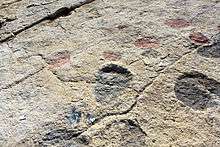Parabrontopodus
Parabrontopodus is an ichnogenus of dinosaur footprint, that was initially appointed by Lockley et al. in 1994,[1] and was assigned to Sauropoda by Lockley in 2002 and in 2004 by Niedzwiedzki and Pienkowski. Various species through their footprints that are characterized by the association of two impressions left by hand and foot. The acquisition of a specific family is complex, but now in most cases, they have been considered diplodocoids and similar animals. The reason is that their traces left are large, but in proportion to the size, from animals, seem very light because the depth of imprint is low.
| Parabrontopodus | |
|---|---|
 | |
| Tracks near the A16 highway, Switzerland | |
| Trace fossil classification | |
| Kingdom: | Animalia |
| Phylum: | Chordata |
| Clade: | Dinosauria |
| Clade: | Saurischia |
| Suborder: | †Sauropodomorpha |
| Clade: | †Sauropoda |
| Ichnogenus: | †Parabrontopodus |
Farlow, in 1992, had given a criterion for classifying sauropod tracks. Traces are distinguished wide as Brontopodus (Farlow et al., 1989) and the narrow track related to Breviparopus (Dutuit et al., 1980 cf. Farlow, 1992). As the Parabrontopodus track ratio is 1:5, it is considered narrow by Lockley.
Species recognized
- P. mcintoshi - It was built on the basis of abundant fossil tracks at the Purgatoire site southeast of Colorado, but the holotype is a pair of hands and feet (CU-CTM 190-5). The footprint measures 91 centimeters (3.0 ft). The type species is considered a diplodocoid.
- P. distercii - Based on a trackway consisting of 17 prints of the fore and hind feet found at the site of Salgar Chairs (Soria, Spain). The hind footprints are elongated, averaging 148.5 cm (4.9 ft) long and only 72.7 cm (2.4 ft) wide.[2]
Discoveries concerning Parabrontopodus

- France (Coisia, Jura) (Jurassic, Late Tithonian)
- Italy, in the region of the Dolomites, Lavini di Marco (it), (Jurassic)
These are probably ornithopods. The remains that were attributed to Parabrontopodus because they have similar tracks. The size is 45–50 cm.
- Portugal, near Cabo Espichel (pt) (Kimmeridgian, Tithonian, later Jurassic)
In a path, five brands were found in the other layers of rock in the area, there are also isolated prints, which are poorly conserved.
- Switzerland, Jura Mountains, Training Reuchenette (mid Kimmeridgian, Jurassic)
There are 17 tracks of Parabrontopodus discovered in 2002. They are covered at least six layers, with a total thickness of one meter. In the summer of 2005, a smaller fossil was found, spread about 2 meters (6 ft 6.7 in) on a trail. The individual traces have a length of 20 cm (0.7 ft) and a width of 13.5 cm (0.4 ft). The animal probably was still in the first year of life.
- Spain, province of La Rioja, Enciso formation (Cretaceous, lower Neocomian)
No further details available.
- Chile, discovered in the formation Termas del Flaco (es) VI Región of the country, dating is estimated at Tithonian (Late Jurassic)
Small traces were named Parabrontopodus by Casamiquela frenkii and Fasola in 1968. This is one case that was considered a titanosaur because unlike them, their limbs were less apart, leaving a trail of footprints close together. The discovery was named before Iguanodonichnus frenkii.
See also
References
- Lockley, M. G.; J. O. Farlow; C. A. Meyer (1994). "Brontopodus and Parabrontopodus ichnogen. nov. and the significance of wide-and narrow-gauge sauropod trackways". Gaia. 10: 135–145.
- Meijide-Fuentes, M., Fuentes-Vidarte, C., Meijide-Calvo, M. 1999. Primeras huellas de saurópodos en el weald de Soria (España). Parabrontopodus disterchii, nov. ichnoesp. I Jornadas Internacionales sobre Paleontología de dinosaurios y su entorno. Salas de los Infantes, Burgos, 23.
Glut, Donald F. (2003). "Appendix: Dinosaur Tracks and Eggs". Dinosaurs: The Encyclopedia. 3rd Supplement. Jefferson, North Carolina: McFarland & Company, Inc. pp. 613–652. ISBN 0-7864-1166-X.